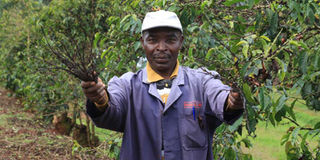Coffee under threat as bacterial blight strikes

Peter Atebe displays coffee twigs infected with Bacterial Blight of Coffee in a farm in Nyeri. The disease is common in high altitude areas characterised by low temperatures, very cold winds and hailstorm. PHOTO | JOSEPH KANYI | NMG
What you need to know:
- The blight is a cold weather disease that usually attacks the crop during the rainy season.
- Farmers are hopeful of a better harvest this year, thanks to the good rains, but experts note coffee production in the county may drop by 50 per cent if nothing is done to contain the disease.
- The disease is common in high altitude areas characterised by low temperatures, very cold winds and hailstorm.
Former Nyeri agriculture executive Robert Thuo says the disease has never been reported in the county. - Farmers are also asked to separate teams working on infected blocks of the plantations as well as ensure workers avoid movement from infected blocks to uninfected one.
When the rains started in March, Joseph Njau noticed a dark-brown shade on his coffee crop.
As a keen farm manager at the Nyeri Hill Farm, he contacted the Coffee Research Institute (CRI), which has since conducted a survey on the farm.
The researchers found the coffee plantation was infected by the Bacterial Blight of Coffee (BBC) disease.
The blight is a cold weather disease that usually attacks the crop during the rainy season. It has attacked tens of coffee plantations in the county and is proving a difficult disease to control for a majority of farmers. The disease causes up to 100 per cent loss.
“Infections start on the apical parts and spread backwards resulting to dieback and eventually death of the trees if not well-managed,” reads a report by the CRI.
On the farm, dozens of trees are affected, with the leaves drying from the tip backwards, and the disease is also affecting the developing berries.
“The disease is contagious and since the rains have been too persistent, it has become hard to control because the soil is too wet, which is a haven for the bacteria,” says Njau.
Farmers are hopeful of a better harvest this year, thanks to the good rains, but experts note coffee production in the county may drop by 50 per cent if nothing is done to contain the disease.
The high infection levels noticed on the farms by the CRI were attributed to the prolonged rainfall period coupled up with the low temperatures in the county.
Nyeri County has so far received 1,056mm of rainfall for the last five months, compared to a maximum of 900mm received normally annually.
The CRI notes that the disease has commonly been prevalent in Nakuru and areas around Mt Elgon and Trans Nzoia but has now spread to Murang’a, Nyeri and Kiambu counties.
SURVEYING FARMS, SCOUTING FOR THE DISEASE
The disease is common in high altitude areas characterised by low temperatures, very cold winds and hailstorm.
Former Nyeri agriculture executive Robert Thuo says the disease has never been reported in the county.
“Farmers in the county are accustomed to battling coffee berry disease and coffee leaf rust, which have also invaded farms due to the cold weather.”
Last year, the two diseases cut coffee production by 20 per cent.
The pathogens causing the bacterial disease occur on the plant surfaces and in the soil mainly spread through surface water, rain splashes, machinery, tools and human body.
“The disease enters the plant through injuries although it also gets to the plant through the natural pores when the pressure is very high,” reads the report.
An infected crop can record severity of between 60 and 80 per cent.
The research institute has advised farmers to ensure tools used to prune crops are to sterilised before being used on another coffee tree.
Farmers are also asked to separate teams working on infected blocks of the plantations as well as ensure workers avoid movement from infected blocks to uninfected one.
All cuttings and debris from an infected tree are also supposed to be isolated and burnt completely.
Movement on the farm, according to the CRI recommendations, should be minimal when the trees are wet since the pathogen causing the disease spreads through plant water surface.
The CRI has recommended two chemicals to control the spread of the disease that is, Copper Sulphate Pentahydrate and Fosphite (Kilifos) to be used as two litres per hectare and six litres per hectare respectively.
“Spraying should be done before the onset of the wet season and it is to be done in intervals of 14 days up to a maximum of 12 to 14 depending on the weather conditions and disease level,” reads the report.
The county department of Agriculture is surveying farms to scout for the disease.
****
Get it fast
32 million kilos produced in 2017
Statistics from the Department of Agriculture indicates that in the 2017/2018 coffee year, Nyeri farmers produced 32 million kilos of clean produce.
This is compared to 26 million kilos in 2016/2017 year despite a poor cli





